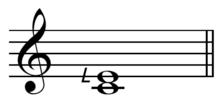Septimal major third
In music, the septimal major third ![]()
![]()
![]()
| Inverse | septimal minor sixth |
|---|---|
| Name | |
| Other names | Supermajor third |
| Abbreviation | S3, SM3 |
| Size | |
| Semitones | ~4½ |
| Interval class | ~4½ |
| Just interval | 9:7[1] |
| Cents | |
| Equal temperament | 400 |
| 24 equal temperament | 450 |
| Just intonation | 435 |

The septimal major third has a characteristic brassy sound which is much less sweet than a pure major third, but is classed as a 9-limit consonance. Together with the root 1:1 and the perfect fifth of 3:2, it makes up the septimal major triad, or supermajor triad ![]()
In the early meantone era the interval made its appearance as the alternative major third in remote keys, under the name diminished fourth. Tunings of the meantone fifth in the neighborhood of Zarlino's 2⁄7-comma meantone will give four septimal thirds among the twelve major thirds of the tuning; this entails that three septimal major triads appear along with one chord containing a septimal major third with an ordinary minor third above it, making up a wolf fifth.
22 equal temperament has a very close match to this interval. In this temperament, four fifths minus two octaves equals a septimal major third, not an ordinary major third.
Sources
- Haluska, Jan (2003). The Mathematical Theory of Tone Systems, p.xxiii. ISBN 0-8247-4714-3. Septimal major third.
- Fonville, J. (Summer 1991). "Ben Johnston's extended Just Intonation: A guide for interpreters". Perspectives of New Music. 29 (2): 106–137. doi:10.2307/833435.
- Fonville (1991), p.128.
- Hermann L. F Von Helmholtz (2007). On the Sensations of Tone, p.187. ISBN 1-60206-639-6.
- Ellis, Alexander J. (1880). "Notes of observations on musical beats". Proceedings of the Royal Society of London. 30 (200–205): 520–533. doi:10.1098/rspl.1879.0155.
- Ellis, Alexander J. (1877). "On the measurement and settlement of musical pitch". Journal of the Society of Arts. 25 (1279): 664–687. JSTOR 41335396.
- Andrew Horner, Lydia Ayres (2002). Cooking with Csound: Woodwind and Brass Recipes, p.131. ISBN 0-89579-507-8. "Super-Major Second".
- "Just Chord Tunings"